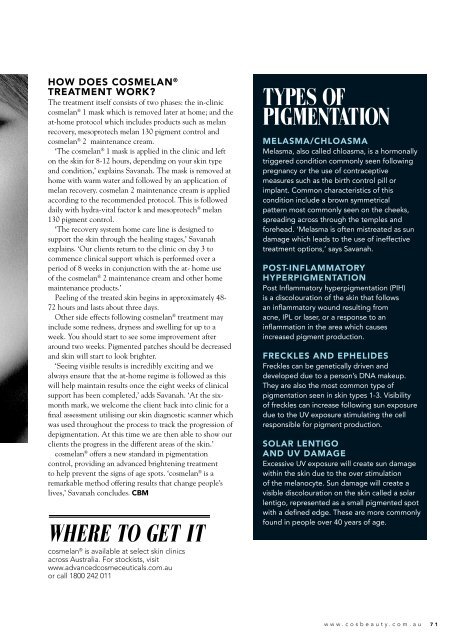CosBeauty Magazine #88
CosBeauty is the #BeautyAddict's guide to lifestyle, health and beauty in Australia. In this issue: - Iso-proof your skin - The products to use in lockdown - Home alone? Make the most of your downtime - Confused? We explain Laser vs IPL - Makeup Style, our current fave looks: Lockdown Chic, Weekend Vibes and #Bossbabe
CosBeauty is the #BeautyAddict's guide to lifestyle, health and beauty in Australia.
In this issue:
- Iso-proof your skin - The products to use in lockdown
- Home alone? Make the most of your downtime
- Confused? We explain Laser vs IPL
- Makeup Style, our current fave looks: Lockdown Chic, Weekend Vibes and #Bossbabe
You also want an ePaper? Increase the reach of your titles
YUMPU automatically turns print PDFs into web optimized ePapers that Google loves.
How does cosmelan ®<br />
treatment work?<br />
The treatment itself consists of two phases: the in-clinic<br />
cosmelan ® 1 mask which is removed later at home; and the<br />
at-home protocol which includes products such as melan<br />
recovery, mesoprotech melan 130 pigment control and<br />
cosmelan ® 2 maintenance cream.<br />
‘The cosmelan ® 1 mask is applied in the clinic and left<br />
on the skin for 8-12 hours, depending on your skin type<br />
and condition,’ explains Savanah. The mask is removed at<br />
home with warm water and followed by an application of<br />
melan recovery. cosmelan 2 maintenance cream is applied<br />
according to the recommended protocol. This is followed<br />
daily with hydra-vital factor k and mesoprotech ® melan<br />
130 pigment control.<br />
‘The recovery system home care line is designed to<br />
support the skin through the healing stages,’ Savanah<br />
explains. ‘Our clients return to the clinic on day 3 to<br />
commence clinical support which is performed over a<br />
period of 8 weeks in conjunction with the at- home use<br />
of the cosmelan ® 2 maintenance cream and other home<br />
maintenance products.’<br />
Peeling of the treated skin begins in approximately 48-<br />
72 hours and lasts about three days.<br />
Other side effects following cosmelan ® treatment may<br />
include some redness, dryness and swelling for up to a<br />
week. You should start to see some improvement after<br />
around two weeks. Pigmented patches should be decreased<br />
and skin will start to look brighter.<br />
‘Seeing visible results is incredibly exciting and we<br />
always ensure that the at-home regime is followed as this<br />
will help maintain results once the eight weeks of clinical<br />
support has been completed,’ adds Savanah. ‘At the sixmonth<br />
mark, we welcome the client back into clinic for a<br />
final assessment utilising our skin diagnostic scanner which<br />
was used throughout the process to track the progression of<br />
depigmentation. At this time we are then able to show our<br />
clients the progress in the different areas of the skin.’<br />
cosmelan ® offers a new standard in pigmentation<br />
control, providing an advanced brightening treatment<br />
to help prevent the signs of age spots. ‘cosmelan ® is a<br />
remarkable method offering results that change people’s<br />
lives,’ Savanah concludes. CBM<br />
WHERE TO GET IT<br />
cosmelan ® is available at select skin clinics<br />
across Australia. For stockists, visit<br />
www.advancedcosmeceuticals.com.au<br />
or call 1800 242 011<br />
Types of<br />
pigmentation<br />
Melasma/Chloasma<br />
Melasma, also called chloasma, is a hormonally<br />
triggered condition commonly seen following<br />
pregnancy or the use of contraceptive<br />
measures such as the birth control pill or<br />
implant. Common characteristics of this<br />
condition include a brown symmetrical<br />
pattern most commonly seen on the cheeks,<br />
spreading across through the temples and<br />
forehead. ‘Melasma is often mistreated as sun<br />
damage which leads to the use of ineffective<br />
treatment options,’ says Savanah.<br />
Post-Inflammatory<br />
hyperpigmentation<br />
Post Inflammatory hyperpigmentation (PIH)<br />
is a discolouration of the skin that follows<br />
an inflammatory wound resulting from<br />
acne, IPL or laser, or a response to an<br />
inflammation in the area which causes<br />
increased pigment production.<br />
Freckles and ephelides<br />
Freckles can be genetically driven and<br />
developed due to a person’s DNA makeup.<br />
They are also the most common type of<br />
pigmentation seen in skin types 1-3. Visibility<br />
of freckles can increase following sun exposure<br />
due to the UV exposure stimulating the cell<br />
responsible for pigment production.<br />
Solar lentigo<br />
and UV damage<br />
Excessive UV exposure will create sun damage<br />
within the skin due to the over stimulation<br />
of the melanocyte. Sun damage will create a<br />
visible discolouration on the skin called a solar<br />
lentigo, represented as a small pigmented spot<br />
with a defined edge. These are more commonly<br />
found in people over 40 years of age.<br />
www.cosbeauty.com.au 71


















